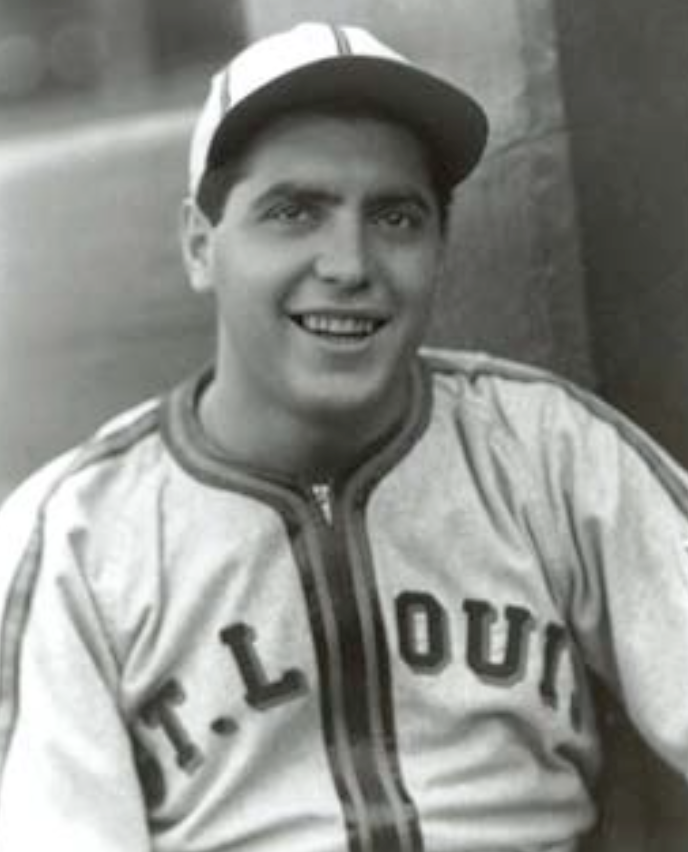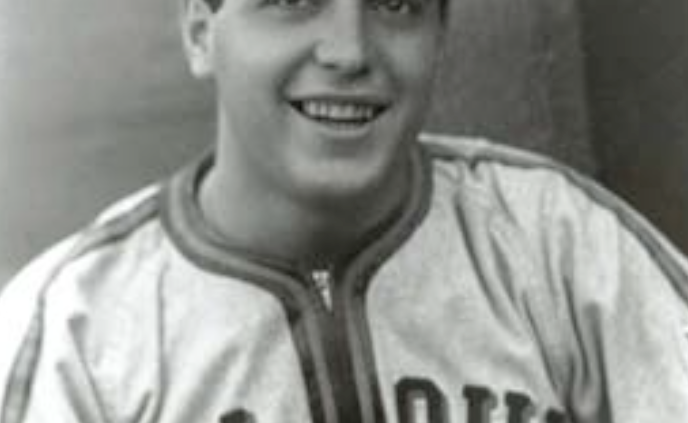Al LaMacchia
 Late in the summer of 1948, Al LaMacchia broke his wrist while playing for the Birmingham Barons of the Southern Association. Since the injury ended his season, he was packing up to head home to San Antonio, where he had lived during the offseason ever since he married a San Antonio girl before World War II.
Late in the summer of 1948, Al LaMacchia broke his wrist while playing for the Birmingham Barons of the Southern Association. Since the injury ended his season, he was packing up to head home to San Antonio, where he had lived during the offseason ever since he married a San Antonio girl before World War II.
But the Barons’ manager caught him on the way out the door. Knowing LaMacchia was a student of the game — it was the only way a guy with an average fastball had survived almost ten seasons, mostly in the minors — the organization wanted to know if he could scout some players in the East Texas League on the way home.
Traveling by bus — he didn’t own a car — LaMacchia found and signed two players the next week.
Once his playing career and a brief period of managing ended in 1954, he took off a year, then got in touch with an acquaintance who worked for the Philadelphia Phillies. The Phillies signed him as a scout in 1955, and he was one almost until the day he died. After two seasons scouring Texas and Oklahoma for the Phillies, he went to work with the Milwaukee Braves. In the 1970s, he went with legendary baseball executive Pat Gillick to an expansion team, the Toronto Blue Jays, and helped take the Jays to back-to-back World Series titles. When the Jays decided he was too old, he “retired” — and then went to work for another expansion team, the Tampa Bay Devil Rays. And then when the Rays decided he was too old, he went to work for the Los Angeles Dodgers. He worked for the club, scouting prospects in the Texas League, through the 2010 season.
Al LaMacchia died on September 15, 2010. The San Antonio Missions honored him the next season, placing a plaque on his favorite seat behind home plate on Al LaMacchia Night at Wolff Stadium.
LaMacchia, the son of Italian immigrants John and Mary LaMacchia, was born on July 22, 1921, in St. Louis. His father worked for the Laclede Gas Co. connecting new homes to the gas system, and his mother took care of the family. Like most kids of his era, he loved baseball, playing on sandlots and the streets of the city’s big Italian community that also produced big leaguers Joe Garagiola and Yogi Berra. His mother once told him baseball was the “stupidest” thing she had ever seen, and at first, he just went along to go along.
His life in baseball dates to the 1930s, when he would sneak out of school to go see games at Sportsman’s Park, home of both the National League’s St. Louis Cardinals and the American League’s Browns. He also discovered he had some ability, pitching in high school at Hadley High School and attracting some interest from scouts. In 1939, when he graduated, the Pittsburgh Pirates’ Joe Schultz, Sr. signed him to a contract. But after stints at Fostoria (Ohio) in the Ohio State League and McKeesport (Pennsylvania) in the Pennsylvania State Association, the Pirates released him after just two months. That opened the door for Browns scout Lou Maguolo, who picked LaMacchia up soon afterward.
A solidly built 5-feet-11 and 190 pounds, the right-hander pitched three seasons in the minors before he was inducted into the Army during World War II, going 16-7 for the Paragould Browns in the Northeast Arkansas League in 1940, 15-5 for the St. Joseph Autos in the Michigan State League in 1941 and 15-16 for the San Antonio Missions in the Texas League in 1942. He met his future wife, Annie, that summer.
After joining the Army LaMacchia picked up even more experience on highly competitive military teams. Shortly before his discharge in 1943, he set a National Baseball Congress record of 20 strikeouts in a game while playing for Fort Riley, Kansas. He made his big-league debut a few weeks later, appearing for the Browns against the Philadelphia Athletics at Shibe Park.
LaMacchia’s major-league career lasted 16 games; he went 2-2 in parts of three seasons with the Browns and the Washington Senators. He played a small role in a high point in the Browns’ history: after going 12-3 at Double-A Toledo in 1944, LaMacchia pitched batting practice for the club during its one World Series appearance, but he was not on the active roster.
He also has a slice of Texas League history. Always known as a fast worker, in 1942 LaMacchia lost 1-0 in the second-fastest game in the league’s history. He joked that if he hadn’t broken a shoelace late in the game, he would be in the record book.
LaMacchia’s life was an adventure; from the days of playing in long-defunct leagues to the night he threw out an honorary first pitch before a World Series game in Toronto. He traveled hundreds of thousands of miles, wore out dozens of cars, saw thousands of players, and talked to thousands of executives, managers, coaches, and players through the years.
Some of them worked out pretty well. LaMacchia scouted and signed Dale Murphy, a two-time National League MVP, and Cito Gaston, who was discovered on a San Antonio sandlot and went on to manage the Blue Jays. His eye for both amateur and professional talent helped build the Jays from an expansion team to a World Series champion, and his efforts earned him and fellow Jays scout Bobby Mattick a rare honor — they were among the first scouts to be named vice presidents in big-league organizations.
There also were the near-misses: LaMacchia recommended a number of other players through the years, passionately making arguments for the Jays to draft Roger Clemens, Barry Bonds, and Tony Gwynn, to no avail.
But Al LaMacchia’s life was more than a story about big-name players. He developed a no-nonsense, take-no-prisoners approach to scouting that made him popular among baseball people across the country. His loyalty was legendary. And he had been known to take a personal interest in young players.
In the summer of 2005 LaMacchia was scouting the Texas League for the Dodgers. He spent most of his time at San Antonio’s Wolff Stadium, catching the league’s young stars as they came to his hometown. He took a particular shine to a young outfielder for the Midland Rock Hounds, the Oakland A’s affiliate in the Texas League, to the point of offering tips during batting practice and engaging the player in long conversations. The outfielder wound up among league leaders in batting average, home runs, and RBIs, and he earned a promotion to Triple-A at the end of the season.
That fall LaMacchia went to Los Angeles for meetings with team executives, who were trying to revive a club that had a 71-91 record in 2005. High among the discussions was the name of Milton Bradley, the talented center fielder who had struggled to fit in with the club, clashing with team leaders like second baseman Jeff Kent.
The Dodgers wanted to trade Bradley and the A’s wanted him. Los Angeles needed a player who could take over a full-time spot in the lineup and produce at the plate the way Bradley had. When the discussion got to LaMacchia, he spoke up. He had a guy, he said, who would be just as productive, and be a positive influence in the clubhouse as well. And he wasn’t even in the major leagues, just a Double-A prospect in the Oakland farm system. LaMacchia made a passionate case — not hard for a guy so passionate about the game — and the Dodgers decided to take a shot.
On December 13, they traded Bradley and infielder Antonio Perez to the A’s for Andre Ethier, the young prospect. Fans and some experts scratched their heads, but LaMacchia knew the deal would wind up being a steal. And it was, as Ethier made the jump from Triple-A to the majors early in 2006 and became a productive regular in the Los Angeles lineup.
LaMacchia downplayed his role in the deal, but the insiders knew he had been a big part of it. Even a scout — and a 50-plus-year veteran scout — can be a superstar, in his own way.
Al’s signings include Ted Savage, Jim Breazeale, Mike McQueen, Larvell Blanks, Jimmy Freeman, Adrian Devine, Jamie Easterly, Mike Beard, Pat Rockett, Mickey Mahler, Joey McLaughlin, Larry McWilliams, Dale Murphy, Rick Mahler, Willie Upshaw, Larry Whisenton, Bruce Benedict, Mike Macha, Rick Matula, Ken Smith, Jim Gott, Lloyd Moseby, Dave Stieb, Andre Robertson, Jim Acker, David Wells, and Mike Coolbaugh.
Photo credit
National Baseball Hall of Fame Library.
Sources
Interviews with Al LaMacchia in April 2002, June 2005, June 2006, August 2007, May 2008, and January 2010
Bill Plaschke, “There’s Trust in His Eyes,” Los Angeles Times, August 16, 2006
Baseball Digest, September 1998
Full Name
Alfred Anthony LaMacchia
Born
July 22, 1921 at St. Louis, MO (USA)
Died
September 15, 2010 at San Antonio, TX (USA)
If you can help us improve this player’s biography, contact us.


